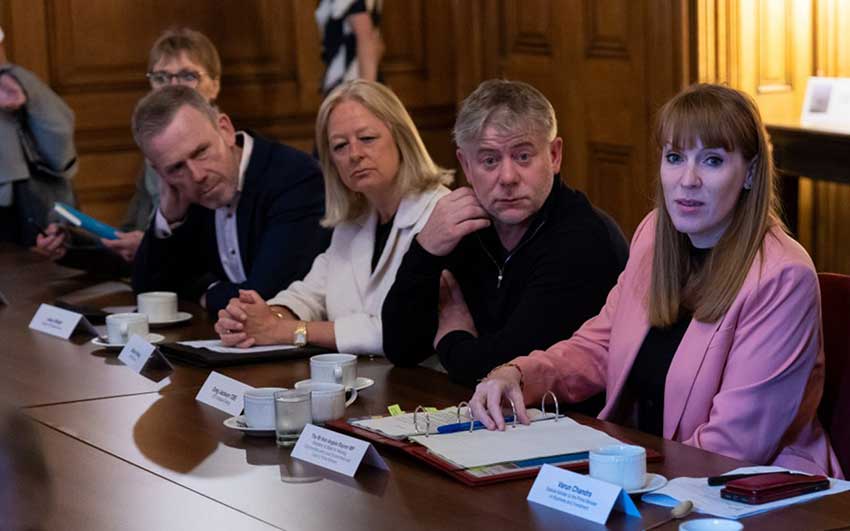One of the world’s largest architecture firms offers a blueprint for successful co-leadership
Hello and welcome to Modern CEO! I’m Stephanie Mehta, CEO and chief content officer of Mansueto Ventures. Each week this newsletter explores inclusive approaches to leadership drawn from conversations with executives and entrepreneurs, and from the pages of Inc. and Fast Company. If you received this newsletter from a friend, you can sign up to get it yourself every Monday morning. Last June, global architecture and design firm Gensler named Elizabeth Brink and Jordan Goldstein as co-CEOs, succeeding Andy Cohen and Diane Hoskins, who jointly led the company for nearly 20 years. Though some U.S. companies, including Netflix, Zola, and Warby Parker, have two chief executive officers, the dual-CEO arrangement remains rare. In a recent joint interview, Brink and Goldstein explained how co-leadership permeates the entire organization—most of Gensler’s offices and its regions are led by pairs—and the way the model helps nurture managerial talent and train future managers to collaborate. They also shared insights into how they make their long-distance partnership work (Goldstein is based in Washington, D.C., and Brink is in Los Angeles), and why the co-CEO model isn’t for every company. Edited excerpts follow: Modern CEO: Let’s start by talking about the co-CEO relationship. You are the second set of co-CEOs at Gensler. Jordan Goldstein: The company started in 1965 and Art Gensler, who founded it, led it for a number of years. The prior CEOs, who actually were mentors to both of us, have now stepped into global chair roles. Elizabeth Brink: The co-leadership model is pretty deep in the organization. JG: We have about 300 co-leaders. My introduction to “co” roles started at the office level. I was a co-office leader starting in 2008. Elizabeth’s been here 20 years, so we’ve known each other for 20 years in the organization. I did the co-office director role, then we each did co-regional roles, then moved into [the co-CEO] roles. My background is definitely heavy in design and design-oriented technology. My experiences in the firm have been focused on design on a global scale, practicing in different locations around the world, working with different cultures, different climates. EB: My background has been more on strategy and pushing our design strategy into areas that we have not been, connecting business and design, and also a little bit on the urban strategy side of things. It’s a really nice balance. I think we are both also people-oriented leaders, and one of the areas where we really overlap is an incredible focus on mentorship. And that’s part of why we work so well as a duo together—because of that kind of commitment. MC: You were elevated to the co-CEO roles simultaneously. But co-leads are not always assigned at the same time, right? JG: Right. For instance, when I was leading the Washington, D.C., office, it was me and another person, and we worked together growing our architectural practice in the D.C. metropolitan area. We did that for a number of years, and then my business partner said, “You know what? I really want to get back to just designing every day.” He stepped back into that everyday work, and then we brought in another individual who was much more oriented around particular industries. She joined me for a couple of years, and then I rotated out. EB: The organization is pretty matrixed, too. We’re always looking at what the needs are within each market, within each office, within each region, and who are the best people to be partnering together to create that balance? But our situation was a little bit different because of the scale [of the roles]. MC: Tell me about how that succession process worked. In your situation, when did it become clear that you were going to be each other’s co-CEOs? EB: We were on our own leadership exploration journeys; we were both getting opportunities across the firm. I had stepped in on building a lot of our work around our people and culture. Jordan had been a really strong design leader. Both of us had been members of the board. And both of us had stepped into some key task force development over the last couple of years. That’s where we really started developing our connection, and I think others saw how well we work together and what we could really bring to the table as a duo. JG: I was really focused on a design career, but as I got into larger, complex projects globally, I really enjoyed the leadership aspect of that. It was 10 years ago when the CEO team [at the time] asked: “Would you be interested in this type of path?” EB: One of the things that’s been so beneficial about both of us having these non-linear career journeys is the depth of relationships that we have stepping into this role. We’re leaning on people who have been peers, who have been mentors to us, who we’ve mentored. MC: Do you share direct reports, or do you divide and conquer? JG: The way we approached it

Hello and welcome to Modern CEO! I’m Stephanie Mehta, CEO and chief content officer of Mansueto Ventures. Each week this newsletter explores inclusive approaches to leadership drawn from conversations with executives and entrepreneurs, and from the pages of Inc. and Fast Company. If you received this newsletter from a friend, you can sign up to get it yourself every Monday morning.
Last June, global architecture and design firm Gensler named Elizabeth Brink and Jordan Goldstein as co-CEOs, succeeding Andy Cohen and Diane Hoskins, who jointly led the company for nearly 20 years.
Though some U.S. companies, including Netflix, Zola, and Warby Parker, have two chief executive officers, the dual-CEO arrangement remains rare. In a recent joint interview, Brink and Goldstein explained how co-leadership permeates the entire organization—most of Gensler’s offices and its regions are led by pairs—and the way the model helps nurture managerial talent and train future managers to collaborate. They also shared insights into how they make their long-distance partnership work (Goldstein is based in Washington, D.C., and Brink is in Los Angeles), and why the co-CEO model isn’t for every company. Edited excerpts follow:
Modern CEO: Let’s start by talking about the co-CEO relationship. You are the second set of co-CEOs at Gensler.
Jordan Goldstein: The company started in 1965 and Art Gensler, who founded it, led it for a number of years. The prior CEOs, who actually were mentors to both of us, have now stepped into global chair roles.
Elizabeth Brink: The co-leadership model is pretty deep in the organization.
JG: We have about 300 co-leaders. My introduction to “co” roles started at the office level. I was a co-office leader starting in 2008. Elizabeth’s been here 20 years, so we’ve known each other for 20 years in the organization. I did the co-office director role, then we each did co-regional roles, then moved into [the co-CEO] roles. My background is definitely heavy in design and design-oriented technology. My experiences in the firm have been focused on design on a global scale, practicing in different locations around the world, working with different cultures, different climates.
EB: My background has been more on strategy and pushing our design strategy into areas that we have not been, connecting business and design, and also a little bit on the urban strategy side of things. It’s a really nice balance. I think we are both also people-oriented leaders, and one of the areas where we really overlap is an incredible focus on mentorship. And that’s part of why we work so well as a duo together—because of that kind of commitment.
MC: You were elevated to the co-CEO roles simultaneously. But co-leads are not always assigned at the same time, right?
JG: Right. For instance, when I was leading the Washington, D.C., office, it was me and another person, and we worked together growing our architectural practice in the D.C. metropolitan area. We did that for a number of years, and then my business partner said, “You know what? I really want to get back to just designing every day.” He stepped back into that everyday work, and then we brought in another individual who was much more oriented around particular industries. She joined me for a couple of years, and then I rotated out.
EB: The organization is pretty matrixed, too. We’re always looking at what the needs are within each market, within each office, within each region, and who are the best people to be partnering together to create that balance? But our situation was a little bit different because of the scale [of the roles].
MC: Tell me about how that succession process worked. In your situation, when did it become clear that you were going to be each other’s co-CEOs?
EB: We were on our own leadership exploration journeys; we were both getting opportunities across the firm. I had stepped in on building a lot of our work around our people and culture. Jordan had been a really strong design leader. Both of us had been members of the board. And both of us had stepped into some key task force development over the last couple of years. That’s where we really started developing our connection, and I think others saw how well we work together and what we could really bring to the table as a duo.
JG: I was really focused on a design career, but as I got into larger, complex projects globally, I really enjoyed the leadership aspect of that. It was 10 years ago when the CEO team [at the time] asked: “Would you be interested in this type of path?”
EB: One of the things that’s been so beneficial about both of us having these non-linear career journeys is the depth of relationships that we have stepping into this role. We’re leaning on people who have been peers, who have been mentors to us, who we’ve mentored.
MC: Do you share direct reports, or do you divide and conquer?
JG: The way we approached it was, for the beginning of our tenure together, we were all in on all [reports] so we could really get the lay of the land and feel where there was natural chemistry within the organization. [A few weeks ago] we mapped it out and said, “All right, given what we’ve experienced, let’s talk through it.” And we just divided it up. And we’re now letting people know she’s first position on this, and I’m first position on that. That doesn’t mean we won’t both be on the calls or both be in a meeting.
EB: What it allows us to do is—when there are challenges, when there are issues—one of us can go really deep. It’s been very beneficial to have spent that time together because we start to understand how we each think about the tricky problems. I know which parts of a problem Jordan’s going to want to know about. And the reverse: He knows what parts are going to be really important for me to understand. And we text all the time.
MC: It seems like trust is such an important part of what makes this co-leadership model work at the regional levels, at the office levels, and crucially at the CEO level.
JG: I think it’s like trust combined with almost like an iterative dialogue.
EB: I will say, to put out the vulnerable part of this, too, over the last year-and-a-half as we’ve been stepping into things, we both made mistakes. We’ve had times where I should have read you in on that. Or said, “Oops, I misread that situation.” But I think where the trust is coming in is in the openness with one another and [acknowledging]: “I made a mistake on that one.” The trust lies in both of our intentions and both of our ambitions to do what’s right for this organization.
MC: Have you had co-leaders at the office or regional level where the pairing didn’t work out?
JG: Yes, and those are obviously delicate conversations because the people can still be valuable to the organization. We just have to help them see a new perspective on how they can contribute, where their value add is, and how that offers career growth opportunities for them. The interesting thing for us is that when the “co” isn’t working, it’s not just something you see in the pairing, you see it in the office. It translates to other aspects of business.
EB: When it works, it really can expand and elevate people’s opportunities to make an impact. But when it doesn’t, we’ve learned to not let that fester. The more you just hope for it to go away, the less it goes away and the more it impacts other people.
MC: Would you recommend co-leadership to other organizations? And if a company is thinking about either starting out with co-leadership or adopting co-leadership, what advice would you give them?
JG: There are some industries where it’s probably a tough fit. We actually get questions from clients [about the model]. It has to be something that can stand up on the pillars of a strategy that is embedded in the organization. The thing we haven’t really talked about is that the “co” model also enables a level of exploration, for pushing innovation in a way that you know surprises people when we talk about it.
When I was an office leader, we talked about [developing] a venture capital mindset, to encourage different thinking. If one person was trying to grow the business and delegated [different thinking], that’s very different than if it’s owned by these two leaders, and they can touch it in different ways. We ended up creating these innovation funds, which were granted based on people’s ideas, which ended up going firmwide.
EB: I think the co-leadership model has enabled really rapid growth, innovation, and iteration. I don’t know that it’s something to put onto an established organization. But I think, particularly for a creative entrepreneurial organization that is looking to grow or provide a platform for [professional] growth for a really talented team of people, it’s a great model.
JG: When I was visiting Elizabeth recently, I spoke at USC’s [University of Southern California’s] business school, and the students were fascinated by the co-CEO model. You could just see the wheels turning because the students never thought about [the CEO role] that way. It was always the CEO as the singular visionary—and that’s not this model.
EB: Ego has to be put aside.
JG: Absolutely.
EB: If you come in with ego, it doesn’t work.
Does your company divvy up leadership roles?
Are you a co-CEO or co-leader in your organization? How do you divide duties, and what are the skills and practices you employ to make the partnership work? Send your comments to me at stephaniemehta@mansueto.com. I’d like to share some of your insights in an upcoming newsletter dedicated to co-leadership.
Read and watch: co-leadership at work
- Inside Netflix’s unusual co-CEO arrangement—and why it works
- Zola co-CEO Rachel Jarrett says you need this skill for a good partnership
- Is it time to consider co-CEOs?






















